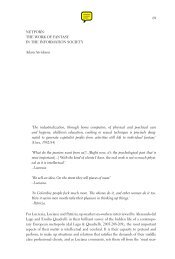Nakamura, Digitizing Race, Introduction, chapter 5, Epilogue
Nakamura, Digitizing Race, Introduction, chapter 5, Epilogue
Nakamura, Digitizing Race, Introduction, chapter 5, Epilogue
You also want an ePaper? Increase the reach of your titles
YUMPU automatically turns print PDFs into web optimized ePapers that Google loves.
Avatars and the Visual Culture of Reproduction 159<br />
duce exist to serve a specific type of orality on the Internet: the kind of<br />
asynchronous conversation that goes on among pregnant women in an online<br />
forum. In these forums, the often “unpredictable flow” of conversation<br />
is directed fairly predictably into a specific path; all discourse that is not<br />
about pregnancy or babies is flagged as an “off-topic” thread so that users<br />
can avoid it. Conversations about the virtues or drawbacks of day care, breastfeeding,<br />
stroller use, and nutrition are generally cordial and tolerant of<br />
diverse opinions, but political discourse is flagged as being off topic, since it<br />
tends to have a divisive effect on the discussion objected to by many of the<br />
participants; this became particularly evident during the U.S. presidential<br />
election in 2004.<br />
Since the orality of pregnancy online is so self-referential—it consists of<br />
pregnant women talking about their pregnancies ad nauseum—the graphical<br />
avatars they create combine “visual, textual, and graphical” structures in<br />
a hybrid form that remediates the pregnant body in truly multifarious ways.<br />
Rather than depicting hypervisible interiors and invisible exteriors, these<br />
women create complicated, at times visually incoherent, embodiments of<br />
pregnancy, a paradigmatically embodied state. Their use of dynamic screens<br />
to reclaim the mode of image production of their own bodies results in rich<br />
and at times bizarre taste cultures online.<br />
Ultrasounds that depict a fetus floating in an undefined space, the invisible<br />
and occluded space of the mother’s body, as well as fetal photography<br />
that encourages the sense of an “independent” fetal body, reinforce the<br />
notion of the pregnant body as really two bodies. As Phelan writes: “Detached<br />
from the pregnant woman, the fetal form has become a sign that is<br />
already powerfully implicated in the political economy of capitalism and<br />
patriarchy.” 40 The persistent envisioning of the pregnant female body as a<br />
vessel (the umbilical cord is painstakingly deleted from most photographic<br />
images of fetuses, thereby emphasizing its existence separately from the<br />
woman’s body) echoes an older cyberutopian notion of the body or “meat”<br />
as a disposable package for what really counts: the mind. The computer scientist<br />
Hans Moravec, “the most exemplary advocate of radical disembodiment,”<br />
sees the flesh as just a carrier or an envelope: a person is an “essence<br />
or pattern,” signal to the body’s noise, and the body is merely “the machinery<br />
supporting that process.” 41 The mind, termed “wetware,” operates like<br />
the software in a computer; it is housed by an apparatus but is transferable<br />
in nature. This notion of the mind/body split is the foundational assumption<br />
and driving force behind cyberpunk fiction and one of the reasons that<br />
theorists claim that new media create a “posthuman” being, one that is





